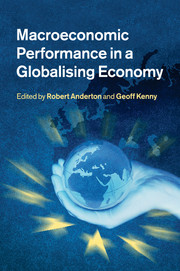Book contents
- Frontmatter
- Contents
- List of figures
- List of tables
- Notes on contributors
- Foreword by Jürgen Stark
- Acknowledgements
- 1 Globalisation and macroeconomic performance
- 2 The impact of globalisation on the euro area macroeconomy
- 3 Trade and foreign direct investment in business services: a modelling approach
- 4 Entry dynamics and the decline in exchange-rate pass-through
- 5 Does the exchange rate belong in monetary policy rules? New answers from a DSGE model with endogenous tradability and trade frictions
- 6 Globalisation and inflation in the OECD economies
- 7 Globalisation and euro area prices and labour markets: some evidence on the impact of low-cost countries
- 8 Monetary policy strategy in a global environment
- 9 Monetary policy in a global economy: past and future research challenges
- Index
- References
8 - Monetary policy strategy in a global environment
Published online by Cambridge University Press: 04 February 2011
- Frontmatter
- Contents
- List of figures
- List of tables
- Notes on contributors
- Foreword by Jürgen Stark
- Acknowledgements
- 1 Globalisation and macroeconomic performance
- 2 The impact of globalisation on the euro area macroeconomy
- 3 Trade and foreign direct investment in business services: a modelling approach
- 4 Entry dynamics and the decline in exchange-rate pass-through
- 5 Does the exchange rate belong in monetary policy rules? New answers from a DSGE model with endogenous tradability and trade frictions
- 6 Globalisation and inflation in the OECD economies
- 7 Globalisation and euro area prices and labour markets: some evidence on the impact of low-cost countries
- 8 Monetary policy strategy in a global environment
- 9 Monetary policy in a global economy: past and future research challenges
- Index
- References
Summary
Introduction
Since the mid 1980s the world economy has gone through profound transformations of which the sources and effects are probably not yet completely understood. The process of continuous integration in trade, production and financial markets across countries and economic regions – which is what is generally defined as ‘globalisation’ – affects directly the conduct of monetary policy in a variety of respects. The aim of this chapter is to broaden the analysis of Chapter 2 (which examined macroeconomic impacts of trade globalisation) to also analyse the structural implications of financial globalisation for the domestic economies of developed countries, and to deduce from these implications lessons for the conduct of monetary policy and associated risks to price stability.
The most prominent stylised fact in the last twenty-five years is, from the point of view of the economic literature, that the level of inflation and its variability around this level has declined in both developed and, at some later stage, developing economies, leading several scholars and professionals to refer to this phenomenon as the ‘Great Moderation’. But other developments have gradually added up and also need to be taken into account. They include global imbalances that have appeared in the current accounts of some large countries as well as the recurrence of booms and busts with global consequences over the last decade and the more recent acceleration and fall of commodity prices, which has ended or, at least, interrupted the ‘Great Moderation’.
- Type
- Chapter
- Information
- Macroeconomic Performance in a Globalising Economy , pp. 235 - 268Publisher: Cambridge University PressPrint publication year: 2010



